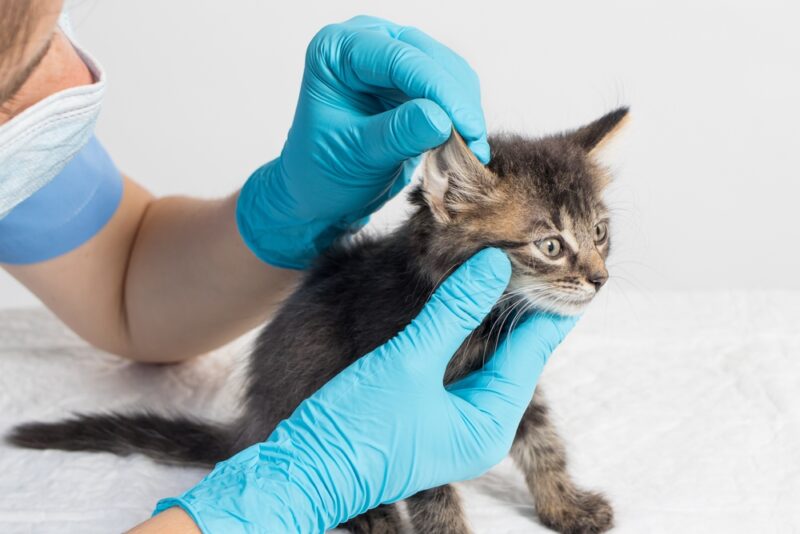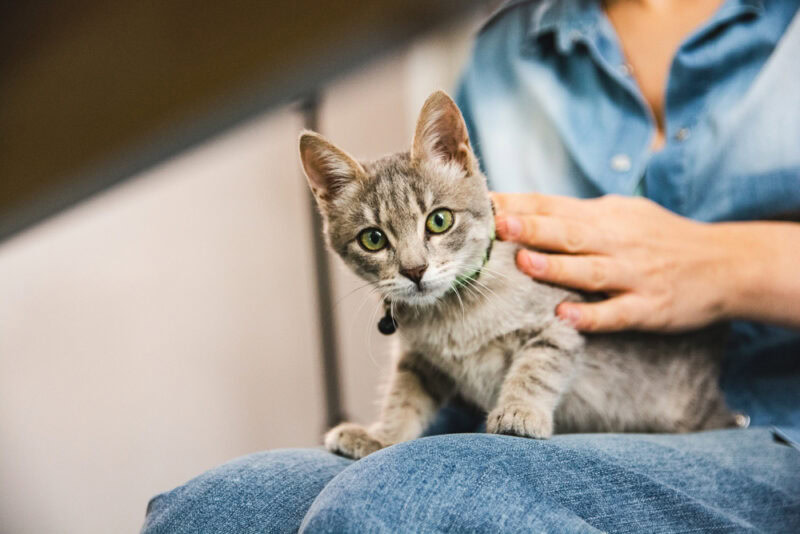VET APPROVED

The information is current and up-to-date in accordance with the latest veterinarian research.
Learn more »Click to Skip Ahead
While scabies is more commonly associated with dogs, cats can also suffer from a form of mange known as cat scabies (Notoedric mange). This skin condition is caused by the microscopic Notoedres cati mite, which burrows into the skin, causing intense itching, inflammation, and hair loss.
If your cat is really itchy and you think they may have scabies, you will understandably want to relieve their discomfort as soon as possible. You may be tempted to use natural or other home remedies you have on hand to try and help them.
Unfortunately, while a few home remedies may provide some temporary relief or be suitable alongside veterinary care, most are ineffective, and some can be harmful. None are substitutes for proper diagnosis and treatment. Ultimately, delaying effective treatment will only prolong your cat’s suffering and can lead to complications like skin infections.
Read on to learn more about cat scabies, treatment options, and why you shouldn’t attempt to treat your cat’s skin condition at home without first seeking advice from a vet.

What is Cat Scabies?
Before exploring treatment options, it helps to understand a bit more about this condition and the need for an accurate diagnosis from a veterinarian.
If you have any questions about cat scabies and its diagnosis or treatment, you can chat with a vet online for advice on the best course of action.
Scabies is a term used to refer to mite infestation with mites of the Sarcoptidae family. Cat scabies is caused by the Notoedres cati mite. This mite burrows under the skin and causes intense irritation. Cats can seem to be relatively resistant to infestation with Sarcoptes scabiei mites that typically cause scabies in people and dogs1.
Cat scabies is rare, but there are regional hotbeds; it seems to be more prevalent in certain areas, including the southern United States and Mexico.

Signs
Cat scabies typically starts with itching, crusts, and scales on the ear margins and then progresses to involve the face and neck. It is sometimes referred to as “Feline Head and Neck Mange” for this reason. If left untreated, it can progress to affect the whole body. Some cats can be infested but not show signs, meaning they can carry and spread the mites to other animals.
- Intense itching
- Crusts and sores, usually starting on the ears and face
- Flakey, inflamed skin
- Patchy hair loss
Cat scabies can resemble many other more common feline skin conditions. Without a correct diagnosis, it can be easy to misinterpret the signs, leading to incorrect and ineffective treatments.
- Flea Allergy Dermatitis
- Other mite infestations,g., Ear mites (Otodectes cynotis) and demodex
- Ringworm
- Environmental or food allergies
- Bacterial skin infections
- Autoimmune disease- pemphigus foliaceus
Diagnosis
The most common way that vets diagnose cat scabies is by taking small skin scrapings and examining them under the microscope to look for the mites or their eggs. They may also need to run tests to rule out other conditions that present with similar signs. Occasionally, skin scrapings don’t reveal any mites, so a vet may do a treatment trial with an anti-parasitic medication known to be effective against scabies mites.

Common Home Remedies and Their Effectiveness
Let’s have a look at the safety and efficacy of some of the commonly suggested home remedies for cat scabies.
Apple cider vinegar (ACV)
ACV is often suggested as a cure-all for a wide range of skin conditions in pets and people due to its reported antibacterial, antifungal, and anti-inflammatory properties. Anecdotally, diluted apple cider vinegar is claimed to alleviate some of the itching and inflammation associated with scabies.
There is no scientific evidence that ACV will treat cat scabies. In fact, topical application of ACV is likely to cause further inflammation on the already sore skin. It is not ideal to use around the face, either, where cat scabies usually affects.
Coconut oil
Coconut oil can moisturize a cat’s skin and may temporarily reduce itching, however, it will not eliminate a mite infestation, and is not suitable as a stand-alone treatment. In addition, cats are fastidious groomers and if they lick and ingest large amounts of coconut oil, it can cause gastrointestinal issues like vomiting and diarrhea due to its fat content.
Honey
While manuka honey does have antibacterial properties and so may help with secondary bacterial infections, it will not kill the mites that cause cat scabies and so should only be used under a vet’s advice alongside effective prescribed treatments.
Boric acid/Borax
Borax is also sometimes suggested as a topical home remedy for treating mange in pets. While it can be used as a household cleaner to deal with mites in the environment, it should not be topically applied to your cat. It is very drying to the skin, causes irritation, and can be toxic if ingested.
Essential Oils
Essential oils, such as tea tree oil, are derived from plants and so often thought of as safe and natural options. Tea tree oil is toxic to cats. Unfortunately, natural doesn’t always mean safe, and essential oils can pose serious risks of toxicity to cats and should be avoided. Essential oils are absorbed quickly orally and through a cat’s skin. Cats lack an essential enzyme in their liver and are unable to metabolize essential oils effectively, which can lead to toxicity.

What is the Treatment for Cat Scabies?
Fortunately, there are several very effective and easy-to-use treatment options for cat scabies that your vet can prescribe once they have diagnosed the problem.
- Prescription flea products that contain an isoxazoline, such as fluralaner (Bravecto), lotilaner (Credelio), and sarolaner (Revolution Plus), are highly effective against feline scabies often after only one dose. None of these products are actually approved for use against Notoedres mites, as cat scabies is rare.
- Selamectin (Revolution), which is a topical antiparasitic medication, can also be used to treat notoedric mange.
- Previously, lime sulfur dips were used to treat cat scabies. Between six and eight weekly applications are typically needed for this treatment to be effective, which is stressful for cats who typically hate being bathed. As much easier and more effective cat-friendly treatment options are available, this method is rarely advised now.
- Ivermectin given as an injection by a veterinarian can also be effective. Usually, three injections every 2 weeks are needed.
- Antibiotics are sometimes prescribed for secondary bacterial infections.
Because Notoedres is so contagious, it’s very important to treat all in-contact cats even if they aren’t showing any signs of cat scabies. Routine treatment with prescription flea products mentioned above should prevent recurrent infestation.

Frequently Asked Questions (FAQ)
Can Cat Scabies Affect People?
People that come into frequent contact with cats with scabies can become infested with Notoedres cati, and develop an itchy skin rash. People are typically affected in areas that have had direct contact with the cats, such as their arms and abdomen, as these mites don’t live off their feline hosts for long. It is self-limiting once people are no longer in contact with infested cats. If you suspect that you have contracted scabies from your cat, you should seek medical advice from your doctor.
What Can I Do at Home to Help?
Cats diagnosed with scabies should be separated from other animals until they have recovered. You can help support their skin health while they recover by making sure they are on a high quality diet and considering cat friendly omega 3 fish oil supplements.
Fortunately, mites can only survive off their feline host for a few days, but it is still a good idea to treat the environment to limit any further spread. Cleaning using standard household disinfectants, vacuuming, and washing all bedding, clothing and toys that the cat has come into contact with, is usually enough to get rid of the mites in the home.


Conclusion
An accurate diagnosis of cat scabies from a veterinarian is essential for effective and safe treatment, as the signs can mimic many other common feline skin conditions. Notoedres mites, which are responsible for scabies in cats, are microscopic and burrow deep into the skin, meaning they are not visible with the naked eye and are difficult to treat with topical home remedies.
While some home remedies may provide temporary relief, most won’t eliminate the mites, leading to potential complications for your cat, including secondary infections, the spread of the infestation, and harmful side effects. The best course of action is to seek veterinary care as soon as possible. Highly effective prescription medications are available and will ensure your cat’s recovery and reduce the risk of spread of these contagious mites to other pets and humans.
See also:
- Notoedric Mange in Cats: Signs, Causes & Care (Vet Answer)
- What Does Mange Look Like on a Cat? Our Vet Explains the Signs & Treatment
- https://pubmed.ncbi.nlm.nih.gov/3804549/
- https://www.sciencedirect.com/topics/agricultural-and-biological-sciences/notoedres-cati
- https://capcvet.org/guidelines/notoedric-mite/
- https://journals.sagepub.com/doi/10.1016/j.jfms.2006.05.005?icid=int.sj-full-text.similar-articles.4
- https://veterinarypartner.vin.com/default.aspx?pid=19239&id=4951396
Featured Image Credit: Suharji Esha, Shutterstock












